Découvertes Gallimard
 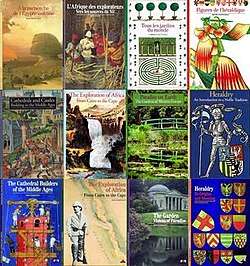 First row: Découvertes Gallimard; second row: Abrams Discoveries; third row: New Horizons. À la recherche de l'Égypte oubliée is the first volume of Découvertes Gallimard collection, the cover features the lithograph Desert of Gizeh by 19th-century Scottish painter David Roberts. | |
|
| |
| Author | Various |
|---|---|
| Country |
|
| Language |
|
| Genre | Humanities, Encyclopaedia |
| Publisher |
|
| Published |
|
| Published in English |
|
| Media type | Print (Paperback, Hardcover) & Digital edition for iPad |
| No. of books |
741: Découvertes Gallimard (589), Découvertes Gallimard : Série « Une autre histoire du XXᵉ siècle » (10), Découvertes Gallimard Albums (13), Découvertes Gallimard Texto (6), Découvertes Gallimard Tirage limité (3), Découvertes Gallimard Hors série (111), Découvertes Gallimard Carnet d'expo (4), Catalogues (5) |
| Website |
www |
Découvertes Gallimard (French: [dekuvɛʁt ɡalimaːʁ], literally in English "Discoveries Gallimard"; in United Kingdom: New Horizons, in United States: Abrams Discoveries) is an encyclopaedic collection of illustrated, pocket-sized books on a variety of subjects, aimed at adults and teenagers.[4] It was created by Pierre Marchand and published by Éditions Gallimard. The first volume À la recherche de l'Égypte oubliée (English-language edition: The Search for Ancient Egypt[5]) appeared in November 1986, written by French Egyptologist Jean Vercoutter.[6] These scholarly little books then released in successive volumes, without a systematic plan, each of which is structured like a separate book (see monographic series). The collection currently contains more than 700 books, including spin-offs.
Overview
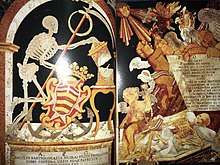
The A6 paper size (125 × 178 mm) is used for these mini books and printed on thick and glossy coated paper, richly decorated with full colour illustrations, from which leap two or three images per page. In this picture-dense format, the authors must squeeze their words in edgewise. Each book of this encyclopaedic collection is composed of a monograph and focuses on a particular topic, the whole series covers all areas of human knowledge and experience,[7] such as history, archaeology, art, aesthetics, music, religion, culture, civilisation, science, geology, biography, the research of supernatural, et cetera. There are 502 expert authors who have written for the collection.[4] They usually use timelines and historical perspective to describe a subject,[8] for example, the 171st title L'heure du grand passage : Chronique de la mort[9] (lit. "The Hour of the Great Passage: Chronicle of the Death"), which narrated in chronological order to present the view of death in Europe from the Medieval Period to the 20th century, through historical vision of cultural, social and religious aspects. Almost all the titles follow the same method, therefore, history is the essential element of perspective for this work.
The captions for illustrations must be informative, they should not duplicate information in the text, nor do they interrupt the narrative thread. Researchers and academics must adhere to the constraints of a mainstream collection. Apart from obvious analytical abilities, authors are asked to write quality text and a sensitivity to illustration. A Découvertes Gallimard is not a book of authorship, the author is only one of the many speakers.[10] Bruno Blasselle, director of the Bibliothèque de l'Arsenal, author of two volumes of Histoire du livre ("History of the Book", № 321 and № 363), and co-author of the 88th title La Bibliothèque nationale de France : Mémoire de l'avenir, explains his experience of working for the collection: "For an author, to write a Découvertes title is to be trapped, to put oneself in a situation of being obliged to go beyond his/her own formulation."[11]
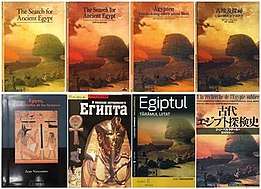
_%E2%85%A0.jpg)
_%E2%85%A0.jpg)
The cover design is one of the specificities. The old covers are glossy with black background illustrated in colour, the newer covers are matt-laminated rather than glossy,[12] but more colourful, with different colour codes according to the areas.[note 1] It differs from other documentary books by its visual: a full-size image, with its framing and the power of figurative elements, also an image that is well-matched to inside page layout. And there is always a tiny image that suits the theme to illustrate the spine. The visual identity is strong, one can even easily recognise different language editions of Découvertes books. However, there are some exceptions, for instance, the Russian publisher AST adopted a completely different cover design for their Открытие ("Discovery") collection.


Each title in the collection has around 200 pages with approximately 120–200 illustrations printed in four, five, six, or seven colours, both matte and glitter, and sometimes even gold, as in the 39th title Richard Wagner : L'opéra de la fin du monde,[10] the metallic gold heightens Carl Otto Czeschka's illustrations from Die Nibelungen. Each book opens with 8–10 full-page illustrations or photographs, prefaced by a pull-quote on the inside front cove, which Thames & Hudson director Jamie Camplin calls it a "cinema-influenced trailer"[1] (called 'pré générique' in French). For the 96th title Champollion : Un scribe pour l'Égypte, this book opens with a succession of reproductions of Champollion's manuscript Grammaire égyptienne; in L'Europe des Celtes[note 2] (№ 158), the reader is greeted by a series of bronze masks and hoary faces carved in stone;[1] the "trailer" for La Saga de l'espace (№ 3) evokes the tragic launch of the space shuttle Challenger in 1986; while that of La Tour de Monsieur Eiffel (№ 62) presents the Eiffel Tower at every stage of its construction.
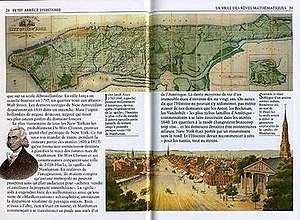
The novelty lies in the subtle orchestration of the text and the illustration, where successive sequences, inserts and foldouts overlapping in double pages.[4] According to the subjects, the body (mentioned as "corpus" in French) is structured into three to seven chapters. Each chapter is built using journalistic methods, with a lead paragraph and intertitle. The "corpus" is punctuated by double-page spreads of images, known as inserts, sort of a halt for pictures. For the 124th title La peur du loup ("Fear of Wolves"), 2 double-page spreads of reproductions of Gustave Doré's engravings to illustrate Little Red Riding Hood. These books benefit a lot from journalistic and cinematographic techniques, some titles include panoramic foldouts, kind of projection on big screen. Two foldouts in the 16th title Pompéi : La cité ensevelie,[note 3] one showing Léon Jaussely's reconstruction of the forum of Pompeii, the other representing the actual condition of the theatre quarter in 1859 by using Paul-Émile Bonnet's drawings, both in a panoramic view. In the 369th title Le papier : Une aventure au quotidien ("The Paper: A Daily Adventure"), through a partnership with paper companies, there are even three luxurious foldouts that all made on different papers from Arjo Wiggins, presenting one of the 17th century watercolours on the traditional manufacture of Chinese paper; the other of the engravings and drawings by Albrecht Dürer and Leonardo da Vinci; the third depicts today's paper production line with its different machines.[10]
At the back of each book is the "Documents" section ("Témoignages et Documents" in French), unlike the "corpus", this part is always printed in black and white. It works as an anthology, provides more detailed documentary information and historical records. This includes dossiers made jointly by the author and the publisher, with lead paragraph to link texts and short captions for each dossier. According to the works, the annexes conclude "Documents" section with a chronology, an index, a filmography, a discography, or a bibliography. The sources of all images are always provided in the "List of Illustrations" ("Table des illustrations") as well as photo credits, dedicated to those who want to do further research. Découvertes also stands out for its attention to detail. On the choice of typeface, for example, Trump Mediaeval is used for common text, Barnattan for intertitles, Zapf Dingbats for guillemets, italic for captions with an initial and the last line is underlined, et cetera. The French editions are printed by Kapp Lahure Jombart in Évreux, while the Italian printer Gianni Stavro, who has largely contributed to the elaboration of new techniques used in the collection, retains his position as collaborator for international reissues and coeditions. The bindings are solid, sewn and not glued.[10] Gallimard promised readers "the most beautiful pocket collection in the world" (« la plus belle collection de poche du monde »).[13]
The collection formerly consisted of 18 series[note 4] which have been abandoned, it is now organised around 7 major areas: Arts, Archéologie, Histoire, Littératures, Religions, Culture et société and Sciences et techniques.
History
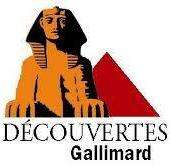
The Découvertes Gallimard collection was born in the Gallimard Jeunesse, based on an idea by Pierre Marchand after the publications of two pocket collections: Découvertes Cadet in 1983 and Découvertes Benjamin in 1984. These three Découvertes collections cater to three levels: grades 4 to 6 (Découvertes Benjamin), grades 7 to 9 (Découvertes Cadet), and grades 10 and up (Découvertes Gallimard).[14] This pocket encyclopaedia initially named "Les chemins de la connaissance" (The Paths of Knowledge), Pierre Marchand already had the idea when he entered Gallimard in 1972, as he explains: "I have invested fourteen years of my professional life in this collection. Thanks to the success of Livres dont vous êtes le héros that we were able to embark on this adventure […] For the first time, genuine encyclopaedias in pocket format […] Our bet is that once you open the book, no matter what subject you read or which page you are on, you can no longer close it."[15] Françoise Balibar, Jean-Pierre Maury, Jean-Pierre Verdet, Marc Meunier-Thouret and some others were the first to experience this pharaonic project that would await the arrival of Élisabeth de Farcy and Paule du Bouchet, in 1981, for truly to take shape.[16] To produce encyclopaedias in pocket format and fully illustrated in colours, in that time, many judged such an editorial project insane.[10] However, the collection was still created in 1986 and directed by Élisabeth de Farcy. She chose the authors and organised iconographic campaigns, several editors and iconographers were then gathered, copious illustrations were extracted from heritage resources. Élisabeth explained in an interview with La Croix: "The image should occupy a central place, as in a work of art."[17] The authors were skeptical about this project at first, even contemptuous, but they are eventually fascinated by the collection. Some have even authored several works, such as Françoise Cachin, curator of the Musée d'Orsay, author of three books – Gauguin : « Ce malgré moi de sauvage »[note 5] (№ 49), Seurat : Le rêve de l'art-science (№ 108), Manet : « J'ai fait ce que j'ai vu »[note 6] (№ 203); or Jean-Pierre Maury, who wrote four titles – Galilée : Le messager des étoiles (№ 10), Comment la Terre devint ronde (№ 52), Newton et la mécanique céleste[note 7] (№ 91) and Le palais de la Découverte (№ 195).[10]
A preview edition, or "zero edition" ("numéro zéro" in French) was sent to 500 booksellers during the summer of 1986,[10] and officially released in November. The first twelve titles, twenty-five thousand copies of each volume were printed.[18] "We've never seen so many things between the first and last pages of a book" is the slogan proposed by Pascal Manry's advertising agency for the launch of the collection. Without market research at the start, Pierre Marchand, a self-taught man, explained on the TV programme Ça se discute: "This project was as old as my thirst for knowledge. No doubt it is necessary to be precisely self-taught to sense the importance of an encyclopaedia. We must have been forced to build our own culture, to seek reliable references, to make clear statements. To conceive Découvertes, I didn't need market research, surveys or tests. Right from the start, I wanted to give the public the books I needed."[19] Although the Découvertes was constituted for youth at the beginning, it was launched for the general adult public in 1986.[20] The collection then had a rapid-growth, 105 titles (volumes) appeared in five years. It acrossed the borders first time with the Spanish co-publisher Aguilar in 1989, and 19 countries will finally be associated with it.[4] In 1992, after 151 titles have been published, Gallimard showed interest in the work on Siren and mermaid (De lokroep van de zeemeermin[21][22]) by Vic de Donder, a Belgian Dutch-language writer. Nevertheless, the Parisian publishing house hesitated: "Interesting subject, but how can you illustrate that?" Then De Donder showed a list of about one thousand images that he gathered over years, Gallimard was convinced and made him the first non-French-language author in this collection.[23]
The heydays of the collection were at the turn of the 1990s, the authors are mainly recruited from academics and curators. Numerous monographs of artists were often published on the occasions of major exhibitions, with a predilection for painters and musicians. Such as the 165th title Matisse : « Une splendeur inouïe »[note 8] was released for the exhibition "Henri Matisse 1904–1917" at the Centre Georges Pompidou in 1993;[10] and Geneviève Haroche-Bouzinac's Élisabeth Vigée Le Brun (from "Hors série") was on sale at the exhibit of Vigée Le Brun's paintings in New York City at the Metropolitan Museum of Art.[24] Or reactivity in relation to current events, for instance, the 161st title Sang pour sang : Le réveil des vampires[25][note 9] was published in 1992 for the release of Francis Coppola's Dracula in the same year; and La mine dévoreuse d'hommes (№ 184)[26] for the release of the French film Germinal; Un Conservatoire pour les Arts et Métiers (№ 222) for the bicentennial of the CNAM; La Mode : Un demi-siècle conquérant (№ 511) was on sale on the occasion of "Yves Saint Laurent retrospective" at the Petit Palais in 2010.[27] Some works were launched within an extremely limited time frame, such as Mémoires du Louvre (№ 60), for the inauguration of the Louvre Pyramid in 1989; and Les Temples de l'opéra (№ 77) for the Opéra Bastille, in 1990, both completed in six to eight weeks instead of the usual two or three months. Alongside many works dictated by current events, there are also a number of favourites, sometimes strange, such as a book devoted to red hair (№ 338 – Roux et rousses : Un éclat très particulier), which is unusual in this type of collection.[10] Some subjects can be more difficult to sell but considered necessary, such as the perspective (№ 138 – La Perspective en jeu : Les dessous de l'image), images of human body (№ 185 – Les images du corps[note 10]) and mannerism (№ 457 – Le maniérisme : Une avant-garde au XVIᵉ siècle).[17] But in recent years, there were more monographs on the memory of places and large institutions instead of artists, as well as various sociological and religious aspects, for instance, a book on the history of New York City by Jerome Charyn, which is translated and adapted from his English work Metropolis: New York as Myth, Marketplace, and Magical Land (№ 204 – New York : Chronique d'une ville sauvage); volumes on homosexuality (№ 417 – La longue marche des gays) and drugs (№ 423 – Les drogues : Une passion maudite); titles about Marian devotions and apparition (№ 401 – La Vierge : Femme au visage divin & № 524 – Le monde de Lourdes). And also numerous volumes devoted to writers, for example, the 381st title Marcel Proust : La cathédrale du temps.[28] Difficult subjects were frequently in demand, possibly because there was less competition. Thus a book on the Cistercian monks (№ 95 – Le rêve cistercien) was one of the bestsellers in 1990. While the others like La fièvre de l'or (№ 34, about gold rush) or Sous le pavillon noir : Pirates et flibustiers (№ 45, about pirates) are presumably subjects more common and popular, were relative failures. Generally, the most popular titles are those from "Arts" and "Archéologie" series, the first title and the 24th title L'écriture, mémoire des hommes[note 11] (both in "Archéologie" series) remain two of the bestsellers.[4] As of 2001, the former would have sold more than five hundred thousand copies worldwide. As for the "Sports et jeux" series, there are only 4 most favoured titles: La saga du Tour de France (№ 81), La balle au pied : Histoire du football (№ 83), Jeux Olympiques : La flamme de l'exploit (№ 133) and Voyous et gentlemen : Une histoire du rugby (№ 164).[10] Competition has emerged as early as in the middle of the 1990s, circulation and novelties have been decreased gradually, but partially offset by another original collection Découvertes Gallimard Hors série, which is like a spin-off.[4]
Today, there are about fifteen old titles from the collection that are updated every year according to the current cultural and scientific research. History is the main point of Découvertes. It is completed by archaeology, art history and science, richly accompanied by unpublished illustrations from ancient times to our days. Thus it forms a solid editorial base.[4] On 25 March 1994, Découvertes Gallimard celebrated its publication of 200th title Voyages en Utopie[29] at the Musée national des Monuments Français.[13] The collection underwent two successive redesigns, one in September 1998 (№ 359 – Le Théâtre de Boulevard : « Ciel, mon mari ! ») for exterior model (colour of book's back-cover, more explicit signage), and the other in March 2000 (№ 390 – L'Esprit des savoirs) for interior page layout.[4] The "Documents" section of those re-editions is shortened, the average pagination of each volume decreases. The collection, which was too soon associated with a zapping visual culture, reaffirmed its first purpose: the image does not take precedence over the text, but combined with text to animate and enrich the reading.[4] These books benefit from the latest technologies, with their mockups are all made using DTP now. Since the X Press software was only released in 1987, the first 30 titles were made in a traditional way, with phototypesetting. The current price of a Découvertes book is between 8.40 and 15.90 euros (£7.95 in UK, $12.95–$14.95 in US and $19.95 in Canada) according to its category and number of pages, this is considered an extremely low price for a book of this quality.[10]
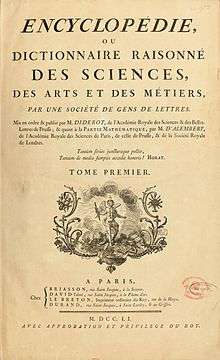
Découvertes Gallimard has been translated into 19 languages[30] (in fact currently more than 20 languages, see Appendix), including English, German, Dutch, Spanish, Italian, Portuguese, Lithuanian, Romanian, Greek, Russian, Japanese, Chinese, et cetera. "This inexpensive pocket encyclopaedia embodies its humanistic dream: to make the most advanced state of knowledge available to everyone. Diderot and D'Alembert would not have denied it…", notes Hedwige Pasquet, current CEO of Gallimard Jeunesse.[30] According to Livres-Hebdo, these "French-style documentaries" have sold over twenty million copies worldwide (as of 1999),[31][32][10] with recently emerging markets in the Eastern Europe and Asia, especially in Russia, about 100 titles have been published within four years. In order to remedy the problems of international proprietaries and reproduction rights of works of art, the co-publishers firstly define a number of titles, then they choose according to their own editorial line, and share the high cost of worldwide photographic rights. Therefore, Abrams Books in the United States chose more titles about traditional cultural subjects, while in Japan, the publisher Sōgensha prefers original titles, such as Les sorcières : Fiancées de Satan[33] (lit. "The Witches: Fiancées of Satan") by Jean-Michel Sallmann. Aguilar from Madrid would be the first one among Découvertes Gallimard's international co-publishers since 1989, the first 12 titles for the Spanish collection Aguilar Universal were released in the same year.[34] In Italy, the publisher Electa/Gallimard produced 128 titles within seven years; in Japan, the 166th title of their collection Chi no Saihakken ("Rediscovery of Knowledge") has been published in early 2017.[35][36] In addition, foreign editions are usually co-printed to amortise fees and support countries with small circulation.[10]
In addition to these foreign co-editions, Découvertes Gallimard has also been involved in institutional partnerships for several years, notably the one held since 1989 with the Réunion des Musées Nationaux (RMN): thirty-two titles have been released (as of 2001), plus a title in English dedicated to Jean-Baptiste-Camille Corot (№ 277 – Corot: Extraordinary landscapes), Impressionism box set and four books in the "Hors série". The principle of these co-editions is based on a sharing of costs and revenues, the RMN brings its knowledge of museums and distribution network, while the publisher brings its editorial competence. When a title is linked to an exhibition, it generates a lot of additional sales through the RMN. Other partnerships with public or private companies, such as the CEA (№ 282 – L'atome, de la recherche à l'industrie : Le Commissariat à l'Énergie Atomique), Crédit Mutuel (№ 379 – L'odyssée de l'euro), L'Oréal (№ 405 – Les vies du cheveu), paper industries (№ 369 – Le papier : Une aventure au quotidien), et cetera. The partner is sometimes explicitly indicated in the "acknowledgments" (№ 379), but it is most often mentioned equivocally (№ 405), even modestly kept in silence (№ 389 – Vive l'eau).[10]
Documentary-style book publishing has been in decline in France for several years, market saturation is one of the causes, competition from other medias is another, especially from the internet. Despite its excellent image to the public, Découvertes Gallimard is also concerned by this disaffection. It remains an indisputable success internationally, but in France, the sales are eroding. The number of new productions decreases and also the prints. On 1 March 1999, the CEO of Gallimard Jeunesse and creator of Découvertes, Pierre Marchand, after working for 27 years at Gallimard, left to become a creative director at Hachette. This was no doubt a big loss to the collection, but with more than 10 years of experience and a rich fund created over years, Découvertes finally surpassed the difficulties.[10] The end of 2006 is marked by the celebration of Découvertes Gallimard's 20th anniversary and the publication of its 500th title Art brut : L'instinct créateur. On this occasion, a website was specially created for the collection, which is now the official website http://www.decouvertes-gallimard.fr. On the occasion of Éditions Gallimard's centennial in 2011, Découvertes Gallimard launched its first digital book for iPad: the 569th title Gallimard : Un éditeur à l'œuvre ("Gallimard: A Publisher at Work") by Alban Cerisier.[4]
Image

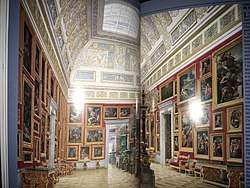
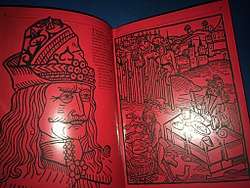
Image is the essential part to Découvertes Gallimard, the collection drew much inspiration from magazine layout designs. Full colour pictures, documentary illustrations, archival photographs, historical maps occupy a central place in this work, as said Pierre Marchand himself: "the language of images is a universal language".[37] But in the 1980s, DTP and photo digitisation did not exist, the sophisticated mockups were entirely handmade and the iconographers ran around museums, libraries, painting galleries and other agencies to look for documents. Today, the technology has simplified all these procedures but the difficulties are elsewhere, the status of the image is increasingly complex.[17]
Contemporary subjects often generate much higher costs since the publisher is obliged to work with photographic agencies. In the choice of documents, priority is given to those original, unpublished images. Besides, the iconographers of Découvertes have some exceptional documents, such as English explorer Frederick Catherwood's original drawings of Maya ruins decorate the 20th title Les cités perdues des Mayas.[note 12][10]
It's not difficult to illustrate subjects like arts, civilisations, archaeology... But when it comes to a theme like "pain" (№ 370 – La douleur : Un mal à combattre) or "sustainable development" (№ 495 – Le développement durable : Maintenant ou jamais), it becomes more delicate. The question is how to avoid repetitiveness or the flatly illustrative image, then the solution lies in a broadening field, through the use of historical documents, works of art and film stills.[17]
Case study in aestheticisation movement
The aestheticisation of postmodern everyday life, according to sociologists Michel Maffesoli and Mike Featherstone, it seems to spring from two parallel movements rooted in modernity, the so-called "dual postmodern aestheticisation movement": first an aesthetic hedonism and second the trivialisation of art. The second movement is the result of the de-academisation and de-institutionalisation of art, thus "art is part of everyday life". Découvertes Gallimard is considered an example of 'art as part of everyday life' within this study.[20]
Pierre Marchand, Head of Gallimard Jeunesse who created the new kind of artistic encyclopaedia with a dynamic layout, that would be as much a magazine as an encyclopaedia. It has been described by a Gallimard employee that Découvertes "seduces like a magazine but has the duration of a book", a kind of objectified specialised luxury magazine. A lot of work and research is done on the reproduction of images and the choice of illustrations, often unpublished documents like antique engravings, old photos, on all types of themes.[38] In this collection, all books share the same concept as to layout and looks, each book itself could become a work of art rather than only its substitute. It is coupled with up-to-date editing equipment, organisational innovations and a constant pursuit of higher printing quality at lower cost. And a more friendship than business relation between Marchand and the Italian printer Gianni Stavro has advanced the state of the art in printing. The suppliers of Découvertes are supposed to cooperate between themselves, "for instance, the French printer had a problem concerning the pigments, so the Italian printer invited him over to explain how he could solve the problem", explained by a Gallimard employee.[20]
Pierre Marchand might not be an "Artistic Master", but he is almost considered as such by his employees. Découvertes' staff work like a team, where everybody is concerned with everything at the same time. They share the same culture and values, their office is intentionally built like a vessel, with Marchand as 'captain' on the bridge, and anyone, at any time, is free to contribute with his/her own ideas about authors, pictures, front covers, …, and becomes leader of a project.[20]
Spin-offs
- Découvertes Gallimard Hors série: The title roughly translates as "off-series" or "off-collection". "Hors série" books are even smaller (120 × 170 mm, generally, but not always), each one consists of 48 pages with full colour illustrations. These books are designed like museum guide booklets, according to Gallimard, "des livres à visiter comme une exposition" (lit. "books to visit like an exhibition"). Most of them are dedicated to artists like Botticelli, Arcimboldo, Fragonard, Soutine, Le Gray, et cetera, during major exhibitions devoted to them.[39]
- Une autre histoire du XXᵉ siècle: Literally means "Another History of the 20th Century". A closed series in Découvertes Gallimard collection released in 1999, consists of ten volumes for ten decades, written by French historian Michel Pierre and based on the Gaumont cinematographic archives.[4]
- Découvertes Gallimard Albums: Consists of 13 volumes, 12 volumes released in 1992 and one in 1994, a larger format (210 × 270 mm) is used for these books.
- Découvertes Gallimard Texto: A 6-volume series released in 1998, inspired by the "Documents" section at the back of every Découvertes Gallimard book.[10]
The "Hors série" books are often coupled with exhibitions and it works well. While the other attempts to diversify the collection have often resulted in resounding commercial failures: the "Albums" and "Texto". Despite an interesting concept: the use of still images from Gaumont archives for "Une autre histoire du XXᵉ siècle", this series has had mixed success.[10]
Reception
French weekly magazine Télérama praised Découvertes Gallimard, describing the work as "they borrow suspense from the cinema, have efficiency of the journalism, literary temperament is their charm, and art is their beauty".[4] New York Magazine described it "a lively interweaving of simple text and clever pictures".[40] German literary scholar and historian Gerhard Prause wrote an article for Die Zeit, reviewed the collection is an "adventure stands for surprise, excitement and amusement. Boredom is already prevented by the curiosity of vivid illustrations which are accompanied by detailed explanations".[41] Rick Poynor wrote in Eye Magazine that the collection "is one of the great projects of contemporary popular publishing".[12] Raleigh Trevelyan's article in The New York Times mentioned D-Day and the Invasion of Normandy from Abrams Discoveries series, said "all volumes in the Discoveries series are ingeniously designed".[42] Art critic John Russell considered these books contain unique information, such as Aelian's authority on the musicality of the elephant or the precise look of Halley's comet as it was depicted in 1835.[43] In an article from the Argentine newspaper La Nación, Eduardo Gudiño Kieffer said, "The books are excellent assistants for intellectuals, writers, journalists and students of different aspects of the culture […] they contain accurate and pithy information […] They obtain a cognitive 'duration' difficult to achieve in the mediatic fugacity."[44]
According to French magazine L'Expansion, some other positive reviews including The Mail on Sunday: "Revolutionary… Literally spectacular…"; The Times: "A brand-new and daring collection"; Die Zeit: "As soon as you open these handy books, you can not get away from them anymore"; The New York Times Book Review: "A collection that recalls nineteenth-century encyclopaedias, where intelligence went hand in hand with curiosity".[45] The French news magazine L'Express: "Real monographs, published as art books, offered in pocket format and sold at a pocket price […] Découvertes changed the face of encyclopaedism and art book, adapting the book to the era of 'zapping'."[46]
Despite all the favours to its quality and attractive visual design, the collection suffers from a problem of identity in bookshops: where to put these books? With books for youth or books for adults? As pocket books or human science documentary books? And opt for a thematic scattering on the shelves. Many booksellers renounce the displays that were exclusively reserved for "Découvertes" due to high competition. All the more so because a rather tight inventory management at Gallimard, the complete titles are never available at the same time, which does not appreciate the customers. The problem of identification is also latent in print media, the journalists, even if they are personally delighted to receive the new titles from a press agent, would not be too enthusiastic about presenting a simple pocket book in their articles, even if it's a brand new title and not a reprint.[10]
English edition

_%E2%85%A3.jpg)
Découvertes books have been selectively translated into English, published by Thames & Hudson in United Kingdom under the title New Horizons series,[47][48] which launched its first titles in 1992 with the slogan, "the expanding universe between two covers". According to Thames & Hudson director Jamie Camplin, the remit is to "educate in an entertaining way".[1]
Paul Gottlieb, former director and editor in chief of the New York-based publisher Abrams Books (then called Harry N. Abrams), discovered Pierre Marchand's "Découvertes" collection at the Gallimard stand during the Bologna Book Fair in 1991, which he called "a dazzling array of books" and an "imaginative combination of text and pictures in a magnificently produced series of paperback books". He began to negotiate for English language translation.[49] The collection was eventually titled Abrams Discoveries series by the U.S. publisher. They began to publish in the spring of 1992, and more than 100 titles were produced.[50][51][52][53]
These two publishers share the translation costs, the American edition is then re-edited to take into account English spelling, or vice versa.[1] Unlike the original French edition which each volume has a number on the book's spine, the American and British editions are not put into numerical order. UK edition's book spines have titles in white with black background, while the more Gallimard-style US edition has titles in colour and sometimes with decorative features, like an ☥ for Cleopatra: The Life and Death of a Pharaoh and a ⚜ for Heraldry: An Introductin to a Noble Tradition. As for the "Documents" section, though some co-publishers print the entire French version, Thames & Hudson reformulates this part, tailoring the material to suit the nuances of the UK market.[1]
List of English-translated volumes
Documentary adaptation
In 1997, Découvertes Gallimard started its documentary film adaptations. The project is a co-production of Arte France and Trans Europe Film, in collaboration with Éditions Gallimard.[54] These 52-minute films are produced as episodes for ARTE documentary TV series L'aventure humaine ("The Human Adventure"), most of them are directed by Jean-Claude Lubtchansky.[55]
List of documentary films:
| Documentary | Literal meaning | Director | Release year | Adaptation of | UK edition | US edition | Author |
|---|---|---|---|---|---|---|---|
| Il était une fois la Mésopotamie | "Once Upon a Time in Mesopotamia" | Jean-Claude Lubtchansky | 1998 | Il était une fois la Mésopotamie (№ 191) | – | – | Jean Bottéro, Marie-Joseph Stève |
| Quand le Japon s'ouvrit au monde | "When Japan Opened to the World" | Jean-Claude Lubtchansky | 1998 | Quand le Japon s'ouvrit au monde (№ 99) | – | – | Francis Macouin, Keiko Omoto |
| Galilée, le messager des étoiles | "Galileo, the Messenger of the Stars" | Jean-Claude Lubtchansky | 1999 | Galilée : Le messager des étoiles (№ 10) | – | – | Jean-Pierre Maury |
| Vers Tombouctou – L'Afrique des explorateurs | "Towards Timbuktu – Africa of the Explorers" | Jean-Claude Lubtchansky | 1999 | Vers Tombouctou : L'Afrique des explorateurs II (№ 216) | – | – | Anne Hugon |
| Les cités perdues des Mayas | "The Lost Cities of the Mayans" | Jean-Claude Lubtchansky | 2000 | Les cités perdues des Mayas (№ 20) | Lost Cities of the Maya | Lost Cities of the Maya | Claude-François Baudez, Sydney Picasso |
| Champollion, un scribe pour l'Égypte | "Champollion, a scribe for Egypt" | Jean-Claude Lubtchansky | 2000 | Champollion : Un scribe pour l'Égypte (№ 96) | – | – | Michel Dewachter |
| L'empire des nombres (available in English) | "The Empire of Numbers" | Philippe Truffault | 2001 | L'empire des nombres (№ 300) | Numbers: The Universal Language | Numbers: The Universal Language | Denis Guedj |
| Léonard de Vinci, art et science de l'univers (available in English) | "Leonardo da Vinci, Art and Science of the Universe" | Jean-Claude Lubtchansky | 2001 | Léonard de Vinci : Art et science de l'univers (№ 293) | Leonardo da Vinci: Renaissance Man | Leonardo da Vinci: The Mind of the Renaissance | Alessandro Vezzosi |
| La terre des Peaux-Rouges | "The Land of the Redskins" | Jean-Claude Lubtchansky | 2002 | La terre des Peaux-Rouges (№ 14) | – | – | Philippe Jacquin |
| Angkor, la forêt de pierre | "Angkor, the Stone Forest" | Jean-Claude Lubtchansky | 2002 | Angkor : La forêt de pierre (№ 64) | Angkor: Heart of an Asian Empire | Angkor: Heart of an Asian Empire | Bruno Dagens |
| Darwin et la science de l'évolution | "Darwin and the Science of Evolution" | Valérie Winckler | 2002 | Darwin et la science de l'évolution (№ 397) | Charles Darwin: The Scholar Who Changed Human History | Darwin and the Science of Evolution | Patrick Tort |
| Le mystère des sources du Nil | "The Mystery of the Sources of the Nile" | Stéphane Bégoin | 2003 | L'Afrique des explorateurs : Vers les sources du Nil (№ 117) | The Exploration of Africa: From Cairo to the Cape | The Exploration of Africa: From Cairo to the Cape | Anne Hugon |
Appendix
List of different language editions of Découvertes Gallimard.
| Title | Literal meaning | Language | Country | Publisher | First published |
|---|---|---|---|---|---|
| Découvertes Gallimard | "Discoveries Gallimard" | French of France | France | Éditions Gallimard | 1986 |
| New Horizons | – | British English | United Kingdom | Thames & Hudson | 1992 |
| Abrams Discoveries | – | American English | United States | Abrams Books | 1992 |
| Universale Electa/Gallimard | "Universality Electa/Gallimard" | Italian | Italy | Electa/Gallimard | 1992 |
| Aguilar Universal | "Aguilar Universal" | Peninsular Spanish | Spain | Aguilar, S. A. de Ediciones | 1989 |
| Biblioteca Ilustrada | "Illustrated Library" | Peninsular Spanish | Spain | Blume | 2011 |
| Biblioteca de bolsillo CLAVES | "Pocket Library KEYS" | Spanish | Spain, Hispanic America | Ediciones B | 1997 |
| Civilização/Círculo de Leitores | "Civilisation/Readers' Circle" | European Portuguese | Portugal | Civilização Editora, Círculo de Leitores | 1991 |
| Descobrir | "Discover" | European Portuguese | Portugal | Quimera Editores | 2003 |
| Descobertas | "Discoveries" | Brazilian Portuguese | Brazil | Editora Objetiva | 2000 |
| En värld av vetande | "A World of Knowledge" | Swedish | Sweden | Berghs förlag | 1991 |
| Horisont-bøkene | "Horizon Books" | Norwegian | Norway | Schibsted | 1990 |
| Ny viden om nyt og gammelt | "New Knowledge on New and Old" | Danish | Denmark | Roth | 1993 |
| Abenteuer Geschichte | "Adventure Story" | German | Germany | Ravensburger Buchverlag | 1990 |
| Fibula Pharos | "Fibula's Pharos" | Dutch | Netherlands | Fibula-Van Dishoek | 1990 |
| Standaard Ontdekkingen | "Standaard Discoveries" | Dutch | Belgium, Netherlands | Standaard Uitgeverij | 1990 |
| Krajobrazy Cywilizacji | "Landscapes of Civilisation" | Polish | Poland | Wydawnictwo Dolnośląskie | 1994 |
| Poznać i Zrozumieć Świat – Focus | "Know and Understand the World – Focus" | Polish | Poland | Gruner+Jahr Polska | 2002 |
| Horizonty | "Horizons" | Czech | Czech Republic | Nakladatelství Slovart | 1994 |
| Horizonty | "Horizons" | Slovak | Slovakia | Vydavateľstvo Slovart | 1994 |
| Kréta könyvek | "Crete Books" | Hungarian | Hungary | Park Kiadó | 1991 |
| Mejniki | "Milestones" | Slovene | Slovenia | DZS | 1994 |
| Atradimai Baltos lankos | "Discoveries Baltos lankos" | Lithuanian | Lithuania | Baltos lankos | 1997 |
| Enciclopediile Découvertes | "Encyclopaedias Découvertes" | Romanian | Romania | Editura Univers | 2007 |
| Ανακαλύψεις Δεληθανάση | "Discoveries Delithanasi" | Greek | Greece | Αστέρης Δεληθανάσης (Asteris Delithanasis) | 1990 |
| Открытие | "Discovery" | Russian | Russia | Астрель, АСТ | 2001 |
| Genel Kültür Dizisi | "General Culture Series" | Turkish | Turkey | Yapı Kredi Yayınları | 2001 |
| اكتشافات غاليمار | "Discoveries Gallimard" | Lebanese Arabic | Lebanon | دار المجاني (Dar Al Majani; lit. "Free House") | 2011 |
| 知の再発見 | "Rediscovery of Knowledge" | Japanese | Japan | Sōgensha | 1990 |
| 發現之旅 (Voyage D'exploration) |
"Voyage of Discoveries" | Traditional Chinese | Taiwan | China Times Publishing | 1994 |
| 发现之旅 (Voyage D'exploration) |
"Voyage of Discoveries" | Simplified Chinese | China | Published by various publishers | 1998 |
| 시공 디스커버리 총서 (Sigong Discovery) |
"Sigong Discovery series" | Korean | South Korea | Sigongsa | 1995 |
Notes
- ↑ Red for Arts, brown for Archéologie, blue for Histoire, white for Littératures, dark blue for Religions, yellow for Culture et société, green for Sciences et techniques.
- ↑ American edition – The Celts: Conquerors of Ancient Europe; British edition – The Celts: First Masters of Europe (cy).
- ↑ English edition title (both American and British) – Pompeii: The Day a City Died.
- ↑ The former 18 series: Archéologie, Architecture, Art de vivre, Cinéma, Histoire, Histoires naturelles, Invention du monde, Littérature, Mémoire des lieux, Musique et danse, Peinture, Philosophie, Religions, Sciences, Sculpture, Sports et jeux, Techniques, Traditions.
- ↑ English edition title (both American and British) – Gauguin: The Quest for Paradise.
- ↑ American edition – Manet: The Influence of the Modern; British edition – Manet: Painter of Modern Life.
- ↑ American edition – Newton: The Father of Modern Astronomy; British edition – Newton: Understanding the Cosmos.
- ↑ British edition title – Matisse: The Sensuality of Colour; American edition title – Matisse: The Wonder of Color.
- ↑ British version title – Vampires: The World of the Undead; American version title – Vampires: Restless Creatures of the Night.
- ↑ British version title – The Human Body: Image and Emotion; American version title – Images of the Body.
- ↑ English edition (both American and British) – Writing: The Story of Alphabets and Scripts.
- ↑ English edition title (both American and British) – Lost Cities of the Maya.
References
- 1 2 3 4 5 6 Jim Davies (Summer 1994). "In the beginning was the picture". Eye Magazine. Retrieved 20 April 2017.
- ↑ "Henri Cartier-Bresson - Further Details". Thames & Hudson. Retrieved 5 July 2017.
- ↑ "DISCOVERIES: HENRI CARTIER-BRESSON". Abrams Books. Retrieved 5 July 2017.
- 1 2 3 4 5 6 7 8 9 10 11 12 "Collection Découvertes Gallimard" (in French). Éditions Gallimard. Retrieved 13 April 2017.
- ↑ "The Search for Ancient Egypt (Thames & Hudson edition)". Google Books. Retrieved 14 April 2017.
- ↑ "À la recherche de l'Égypte oubliée, collection Découvertes Gallimard (n° 1)" (in French). Éditions Gallimard. Retrieved 13 April 2017.
- ↑ "New Horizons series". Thames & Hudson. Archived from the original on 6 June 2017. Retrieved 13 April 2017.
- ↑ "Collection Découvertes Gallimard" (in French). Éditions Gallimard. Retrieved 14 April 2017.
- ↑ "L'heure du grand passage : Chronique de la mort, collection Découvertes Gallimard (n° 171)" (in French). Éditions Gallimard. Retrieved 14 April 2017.
- 1 2 3 4 5 6 7 8 9 10 11 12 13 14 15 16 17 18 19 Françoise Hache-Bissette. "Découvertes Gallimard ou la culture encyclopédique à la française". ricochet-jeunes.org (in French). Retrieved 26 September 2017.
- ↑ "Dixième anniversaire de la collection Découvertes". Qu'est-ce qu'elle dit, Zazie ? (in French). 15 May 1997. France 3.
- 1 2 Rick Poynor (24 September 2008). "Revelations in style". eyemagazine.com. Eye magazine. Retrieved 20 April 2017.
- 1 2 "Découvertes Gallimard fête son n° 200 (1994)". YouTube (in French). Retrieved 13 April 2017.
- ↑ Harber, Philip (1988). "French-Language Encyclopedias". umanitoba.ca. Retrieved 30 December 2017.
- ↑ "Comme un film documentaire". Livres Hebdo, n° 47 (in French). Paris: Electre S.A. 17 November 1986.
- ↑ Lallouet, Marie (2 July 2011). "Une vieille histoire". Centre de Recherche et d'Information sur la Littérature pour la Jeunesse (CRILJ) (in French). Retrieved 25 January 2018.
- 1 2 3 4 "Élisabeth de Farcy, directrice de la collection "Découvertes Gallimard" : "Une collection de poche à l'ambition encyclopédique"" (in French). La Croix. 13 November 2006. Retrieved 19 April 2017.
- ↑ "Spécial Gallimard jeunesse". Livres Hebdo, supplément au n° 50 (in French). Paris: Electre S.A. 8 December 1986.
- ↑ "Mon tout, c'est Découvertes Gallimard". Lire (in French). Paris. December 1990.
- 1 2 3 4 Cova, Bernard; Svanfeldt, Christian (1993). "Societal Innovations and the Postmodern Aestheticization of Everyday Life". International Journal of Research in Marketing. Amsterdam: Elsevier. 10: 297–310. Retrieved 27 April 2018.
- ↑ de Donder, Vic. De lokroep van de zeemeermin. Worldcat.org. Standaard Ontdekkingen (in Dutch). Antwerp: Standaard Uitgeverij. ISBN 90-269-6350-5.
- ↑ "Bibliographie des oeuvres en langue néerlandaise parues en traduction française signalées en 1993". DBNL (in Dutch and French). 1994. Retrieved 20 September 2017.
- ↑ Vlaminck, M. (24 October 1992). "Gallimard haalt De Donder binnen". Het Nieuwsblad (in Dutch). Groot-Bijgaarden. p. 15.
- ↑ Diane Joy Charney. "Elisabeth Louise Vigée-Le Brun and the Art of Seduction". Versopolis. Retrieved 3 May 2017.
- ↑ "Sang pour sang : Le réveil des vampires, collection Découvertes Gallimard (n° 161)" (in French). Éditions Gallimard. Retrieved 29 August 2017.
- ↑ "La mine dévoreuse d'hommes". Google Books. Éditions Gallimard. Retrieved 29 August 2017.
- ↑ "Découvertes Gallimard". Facebook (in French). Gallimard. 8 March 2010. Retrieved 27 September 2017.
- ↑ "Marcel Proust : La cathédrale du temps, collection Découvertes Gallimard (n° 381)" (in French). Éditions Gallimard. Retrieved 19 April 2017.
- ↑ "Voyages en Utopie, collection Découvertes Gallimard (n° 200)" (in French). Éditions Gallimard. Retrieved 17 April 2017.
- 1 2 "Découverte". bibliomonde.com (in French). Retrieved 18 April 2017.
- ↑ de Gaudemar, Antoine (20 January 1999). "La "jeunesse" de Gallimard chez Hachette. Pierre Marchand, qui a créé "Découvertes" et tout le secteur jeunesse, passe à la concurrence". Libération (in French). Retrieved 27 December 2017.
- ↑ "Livres Hebdo (nº 321)". Livres Hebdo, n° 321 (in French). Paris: Electre S.A. January 1999.
- ↑ "Les sorcières : Fiancées de Satan, collection Découvertes Gallimard (n° 57)" (in French). Éditions Gallimard. Retrieved 18 April 2017.
- ↑ "AGUILAR UNIVERSAL – La primera enciclopedia ilustrada a todo color en formato de bolsillo". Blanco y Negro (in Spanish). Madrid: Editorial Católica. 12 November 1989. Retrieved 26 September 2017.
- ↑ "「知の再発見」双書166『ヴュイヤール──ゆらめく装飾画』" (in Japanese). Sōgensha. Retrieved 26 September 2017.
- ↑ "Vuiyaru Yurameku Soshoku Ga / Original Title: Vuillard ("Shiri No Saihakken" Sosho)". CD Japan. Sōgensha. Retrieved 26 September 2017.
- ↑ "Un entretien avec Pierre Marchand – Fondateur du département Jeunesse des éditions Gallimard". parutions.com (in French). 12 October 1999. Retrieved 25 January 2018.
- ↑ "Livre — New York : Chronique d'une ville sauvage". New York Mania ! (in French). 4 August 2010. Retrieved 29 December 2017.
- ↑ "HORS SÉRIE" (in French). Gallimard. Archived from the original on 7 March 2016. Retrieved 23 September 2017.
- ↑ Larson, Kay (6 December 1993). "Books: The Smart Set". New York. New York City. p. 127. Retrieved 25 June 2017.
- ↑ Gerhard Prause (21 December 1990). "Abenteuer Geschichte: Eine spannende neue Reihe". www.zeit.de (in German). Die Zeit. Retrieved 17 April 2017.
- ↑ Raleigh Trevelyan (29 May 1994). "Telling It Like It Was". The New York Times. Retrieved 20 April 2017.
- ↑ John Russell (1 November 1992). "While You're Saving for a van Gogh: A Guide to Inexpensive Art Books". The New York Times. Retrieved 21 April 2017.
- ↑ Gudiño Kieffer, Eduardo (20 January 1999). "Cultura de bolsillo: CLAVES Por varios autores (Ediciones B)". La Nación (in Spanish). Retrieved 13 January 2018.
- ↑ Roger Alexandre (20 December 1993). "Gutenberg fait de la résistance". L'Expansion (in French). Retrieved 3 January 2018.
- ↑ Garcia, Daniel (1 November 2005). "L'invention des Découvertes". L'Express (in French). Retrieved 31 August 2018.
De véritables monographies, éditées comme des livres d'art, proposées en format poche et vendues à un prix poche […] « Découvertes » a changé la face de l'encyclopédisme et du livre d'art, adaptant le livre à l'ère du « zapping ».
- ↑ "Books: New Horizons series". Thames & Hudson. Retrieved 19 June 2017.
- ↑ "New Horizons (Thames and Hudson) - Book Series List". www.publishinghistory.com. Retrieved 19 June 2017.
- ↑ Hedwige Pasquet; Christine Baker; Christopher Davis; Paul Gottlieb; Herbert Lottman; Dick Robinson; Klaus Flugge; Peter Mayer (May 27, 2002). "Pierre Marchand Remembered". publishersweekly.com. Retrieved March 17, 2018.
- ↑ "Search Results: Discoveries". Abrams Books. Retrieved 19 June 2017.
- ↑ "Abrams Discoveries series - 91 book (incomplete)". Thriftbooks. Retrieved 13 April 2017.
- ↑ "An incomplete list of Abrams Discoveries series". Goodreads. Retrieved 18 January 2018.
- ↑ Barrie Kerper. "Paris: The Collected Traveler". Google Books. Knopf Doubleday Publishing Group. Retrieved 20 April 2017.
- ↑ "Collection DÉCOUVERTES: Une coproduction ARTE France / Trans Europe Film / Gallimard" (PDF). pro.arte.tv (in French). Arte France. 2 March 2002. p. 6. Retrieved 1 October 2017.
- ↑ "Catalogue des films de Jean-Claude Lubtchansky". www.lussasdoc.org (in French). Retrieved 8 June 2017.
Sources
- (in French) Découvertes Gallimard ou la culture encyclopédique à la française by Françoise Hache-Bissette, senior lecturer at the Paris Descartes University. This article is published in the conference proceedings at Sorbonne in December 2001.
- In the beginning was the picture: NEW HORIZONS by Jim Davies at Eye
- Revelations in style: Gallimard’s Découvertes series secures readers’ loyalty by showing respect for their curiosity and intelligence by Rick Poynor at Eye
External links
| Wikimedia Commons has media related to Découvertes Gallimard. |
- Découvertes Gallimard (in French)
- Découvertes Gallimard Hors série (in French)
- Découvertes Gallimard Texto (in French)
- Découvertes Gallimard Albums (in French)
- Une autre histoire du XXᵉ siècle (in French)
- The Search for Ancient Egypt Book Summary and Study Guide
- Alexander the Great: The Heroic Ideal (Thames & Hudson New Horizons Books) at The Irish Times
- Leonardo da Vinci: Renaissance Man (New Horizons, Thames & Hudson) at The Irish Times
- Dada: The Revolt of Art by Marc Dachy at The Independent
- Review of Khmer: The Lost Empire of Cambodia (New Horizons) at Cambridge University Press
- Standing Stones: Stonehenge, Carnac and the World of Megaliths at Danny Yee's Book Reviews